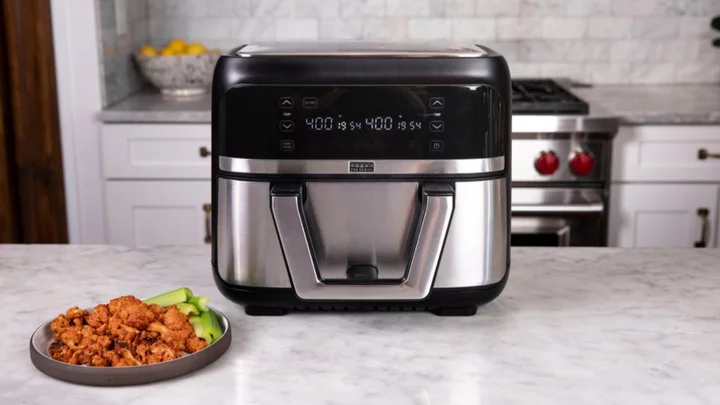There's nothing like the look and smell of freshly cut grass. But unless you're paying for a professional landscaping service, you have to put in a lot of time to keep your lawn in tip-top shape. You can spend hours every week doing the work yourself the old-fashioned way or you can invest in a robot lawn mower.
Available for lawns of all shapes and sizes, robot lawn mowers are relatively easy to set up and program. And because they rely on rechargeable battery packs for power, they're super quiet. That means you can run them at any hour of the day without bothering the neighbors. They aren't cheap, however, and you pay more for features like rain and anti-theft sensors, Bluetooth or Wi-Fi connectivity, a mobile companion app, and flexible scheduling capabilities. The same goes for models that can handle larger lawns with steep grades and obstructions such as flower beds, trees, and ornamental decorations.
Read on to see our top picks and find out which robotic lawn mower is best for you based on your lawn size and budget.
How Do Robot Lawn Mowers Work?
Robot lawn mowers look similar to robot vacuums. In action, it's almost like watching a Roomba darting around your lawn, tidying things up. When it comes to what's inside, however, things couldn't be more different.
Most robot mowers rely on a perimeter wire to keep them from wandering off your lawn or into the street, but we have tested one model, the EcoFlow Blade, that does away with wires in favor of satellite-positioning technology. If you do opt for a traditional model, one end of the perimeter wire connects to a terminal on an AC-powered base station and you lay the rest of it along the border of your lawn with stakes. Then, you connect the wire to the second terminal on the base station. Aside from providing that wire with an electrical charge, the base also recharges the mower once it docks. Sensors on the mower guide the mower along the boundaries of your yard and help it navigate back to the base when the device completes a job or starts to run low on power.
Gardena Robotic Mower Sileno City (Credit: Gardena)Speaking of the battery, robotic mowers use a rechargeable pack (usually lithium-ion) that can last anywhere from 30 minutes for an entry-level model up to four or more hours for a high-end mower. Depending on the size of the mower and the battery capacity, expect charging times of anywhere between 30 minutes and two hours or more.
You typically handle programming via an onboard control panel with a power button and menus for setting seasonal timers, scheduling cutting times, creating zones, configuring edge-cutting settings, running diagnostics, and viewing the cutting history. Nearly all robotic mowers are quiet and operate within the 55dB to 60dB range, but a few models put out up to 75dB of sound. Gas-powered mowers typically run between 85dB and 95dB. You can run the quieter mowers at night (some even have headlights), but you should probably run the louder models only in the daytime.
Consider Your Lawn Size and Cutting Deck
Before purchasing a robotic lawn mower, you first need to figure out the size of your lawn. Residential models typically have a working capacity between 0.20 acres and 1.25 acres. A mower for larger lawns has a higher-capacity battery pack that allows it to work longer and travel farther between charges. The shape of your lawn also comes into play: If you have things like flower beds, trees, or fencing, the mower has to use more battery power to navigate these obstructions than if it were just cutting a rectangular or square plot.
The cutting deck refers to the area underneath the mower where the blades spin. Most robotic mowers use a floating deck design that allows you to quickly adjust the cutting height and prevent the blade from scalping the grass in higher spots. Different mowers use different types of cutting blades. For example, some mowers use a single spinning blade configuration while others use multiple spinning blades or a spinning disc lined with multiple razors.
The mower's cutting width determines how wide a swath it cuts on a single pass. Models for smaller lawns may only have a 7-inch cutting width, while mowers for big lawns offer cutting widths of around two feet. All robotic mowers cut the grass into a fine, almost sawdust-like state that works its way into the soil as mulch that fertilizes your lawn. Equally important, there's no bagging involved.
How Much Does a Robot Lawn Mower Cost?
Robotic lawn mowers aren't cheap, but, in most cases, light-duty mowers are significantly more affordable than their heavy-duty counterparts. Whatever you do, make sure you buy a mower that can handle your lawn. Most vendors have online calculators to help you choose the right model for your needs, and many of them can send a representative out to your house to do a site check. Expect to pay anywhere from $600 or more for a bare-bones model, to more than $5,000 for a mower with all the bells and whistles. Dealers that require professional installation may add hundreds of dollars to the total cost.
Once you narrow your choices based on lawn complexity and working capacity, it's time to consider features. Look for a mower with flexible programming options that allow you to create schedules for multiple zones. For example, if you have a large lawn, you might want to split it into multiple zones and set the mower to concentrate on specific zones on specific days. With multi-zone schedules, the mower travels directly to the area you specify before it begins cutting, which saves battery life.
Most robotic mowers operate in rainy conditions but that can get messy. Caked-up grass cuttings tend to stick to the deck, blades are likely to need frequent cleaning, and some mowers might struggle with wheel slippage. Look for a mower with a weather-sensing feature that tells it to return to its base in the event of a heavy downpour.
If you have a lawn with lots of hills and slopes, you need something with large wheels that can navigate the changing landscape. Most mowers can handle slopes of up to 20 degrees, but some can handle slopes of up to 30 degrees. Husqvarna's 435X AWD can manage extreme slopes with an incline of up to 70%.
Some robotic mowers let you adjust the cutting height using a dial on the mower, while others let you make this adjustment electronically at the control panel or via a mobile app. Although all mowers use advanced algorithms to ensure total lawn coverage, some models also utilize GPS technology that tells the mower where it's been and where it needs to go. Some robotic mowers offer built-in Bluetooth, Wi-Fi, or cellular circuitry that lets you program and control the mower using a mobile app and track mowing progress from anywhere.
A few models even let you use your phone as a remote control to guide the mower to certain areas for spot maintenance. Other features to look for include a dedicated remote, a spare set of cutting blades, and an anti-theft system that locks operations behind a PIN when someone picks it up. Some mowers also have an audible alarm and use GPS tracking to help you locate it if someone steals it.
Husqvarna Automower 435X AWD (Credit: Husqvarna)Should You Install a Robot Lawn Mower by Yourself or Hire a Professional?
Installing a robotic lawn mower can be tedious depending on the size of your lawn, but it's not very difficult. Nearly all vendors offer online video tutorials and supply written instructions, a measuring tool for laying the wire, a spool of wire, and stakes to hold the wire in place. Count on spending anywhere from an hour or more (depending on the size and complexity of your lawn) on your knees laying wire. Wire-free models can save you from that manual labor, but some setup requirements make them a bit less practical for some yards. The EcoFlow Blade's base station and antenna, for example, require an unobstructed view of the sky.
A handful of robotic lawn mower manufacturers handle the installation for you, but others require you to contract a certified dealer. For the latter case, prepare to spend a bit of money so be sure to get a quote upfront.
Once you install and program your mower, however, all you have to do is keep its cutting deck clean and change its blades every so often.
For more on how to automate the rest of your home, check out the best smart home devices we've tested, as well as the best outdoor smart home devices for your yard. Own a pool? We have a roundup of the top pool cleaners we've tested as well.









